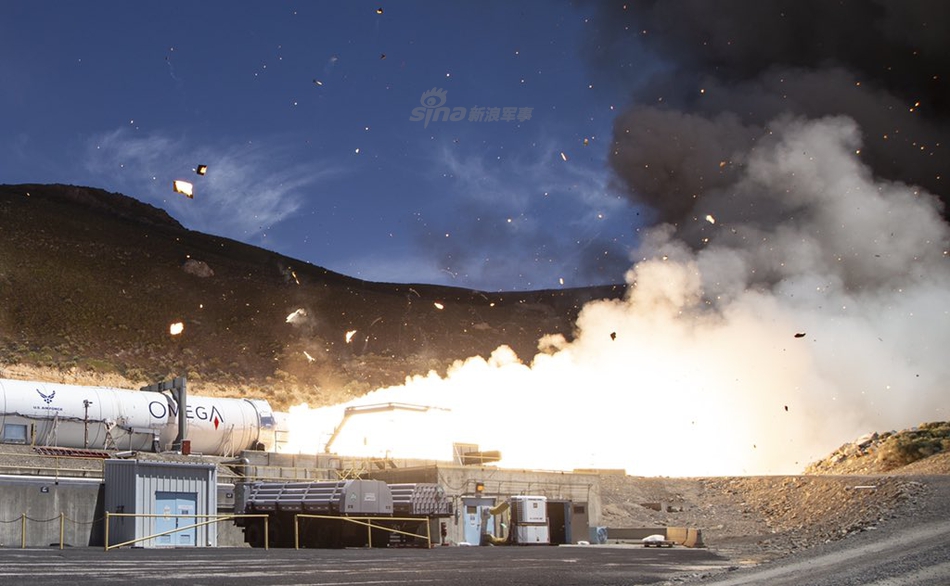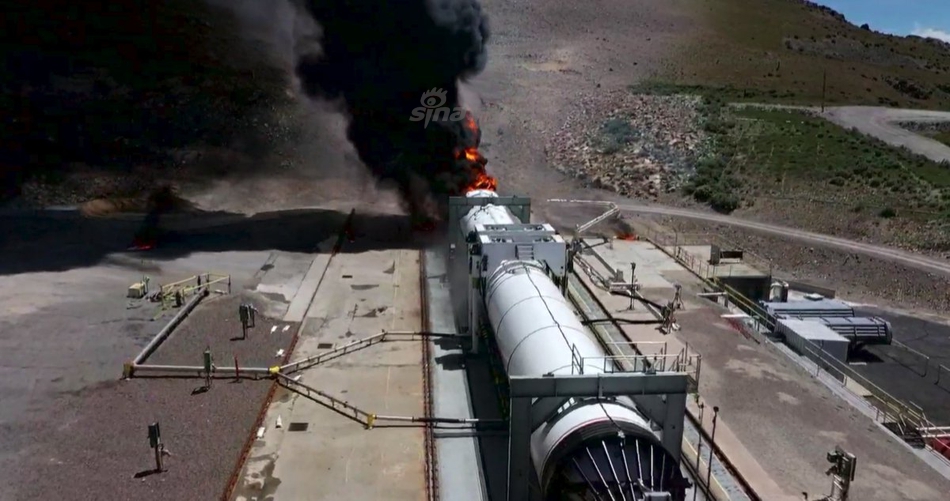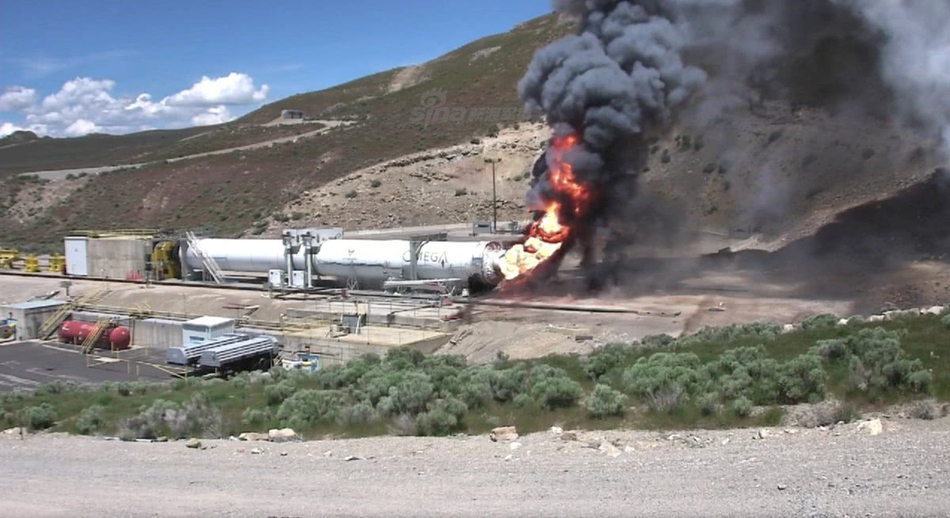NGIS OmegA fires for two minutes in first static test – nozzle incident under review
written by Justin Davenport May 30, 2019

The Northrop Grumman Innovation Systems (formerly Orbital ATK) OmegA rocket conducted a key test today when its Castor 600 first stage fired for two minutes today at the NGIS test facility in Promontory, Utah, at the same test stand used by numerous Space Shuttle and SLS solid rocket motors during their test firings, although there was a situation with the nozzle that NGIS is looking at more closely.
After the end of the Ares 1 and Liberty launch vehicle projects, Orbital ATK developed a next generation launch vehicle concept to compete for future US Air Force and NASA launches, and won a rocket propulsion system (RPS) contract in January 2016 as part of the Air Force’s effort to end its dependence on Russian RD-180 engine imports, due to increased geopolitical tensions between the West and Russia.
The contract enabled Orbital ATK to keep working on the next generation launch system, which was later named OmegA, with the first and last letters capitalized to incorporate the company’s initials.
OmegA's promo video. First launch in 2021. pic.twitter.com/WQwB7Ts1Rp
— Chris B – NSF (@NASASpaceflight) May 30, 2019
— Chris B – NSF (@NASASpaceflight) May 30, 2019
In June 2018 Orbital ATK was acquired by Northrop Grumman to become Northrop Grumman Innovation Systems (NGIS), and in October of that year the US Air Force awarded NGIS a launch service agreement (LSA) contract initially worth $181 million for the first 18 months, and ultimately worth $792 million, to develop, build, and test the OmegA rocket, culminating in four test flights of two configurations starting in 2021.
See Also
NGIS, United Launch Alliance, and Blue Origin were the three companies that won money for Phase 1 of the Air Force contract, with two contractors to be selected later for a five year block of operational missions for Phase 2.
The OmegA, in its intermediate configuration, consists of a two segment Space Shuttle SRB-derived CBS (Common Booster System) Castor 600 first stage and a single segment Castor 300 second stage, as well as a liquid fueled (hydrogen and oxygen) third stage powered by Aerojet Rocketdyne RL-10C engines, which have extensive flight heritage.
In addition, the OmegA can have 1 to 6 smaller GEM-63XLT strap-on boosters mounted on the Castor 600 first stage and jettisoned in flight, to allow for heavier payloads to meet the full spectrum of national security launch needs. Finally, the OmegA features a 5 meter composite payload fairing with ESPA capable rings.
The OmegA intermediate configuration noted above (without GEM-63XLT) is scheduled to fly the first contracted test launch of the OmegA in 2021, while the second OmegA is set to fly the same intermediate configuration later that year but with two GEM-63XLT strap-on boosters added.

The OmegA first stage during the test – via Justin Davenport for NSF
The intermediate configuration is expected to fly the lion’s share of OmegA missions. An OmegA heavy configuration is also being developed, with a 4 segment Castor 1200 first stage and a single segment Castor 300 second stage, along with the RL-10C powered third stage and optional GEM-63XLT strap-on boosters.
The OmegA intermediate configuration will be capable of launching from 10,800 to 22,300 pounds (4900 to 10100 kilograms) to geostationary transfer orbit (GTO), while the heavy configuration can launch 11,570 to 17,200 pounds (5250 to 7800 kilograms) directly to geostationary equatorial orbit (GEO).
Launches will initially take place from the Kennedy Space Center Pad 39B, and High Bay 2 in the Vehicle Assembly Building (VAB) will be used to stack the OmegA for launch, on Mobile Launch Platform-3 (MLP-3) which was used for Space Shuttle flights and will be suitably modified for OmegA operations.

OmegA on 39B at KSC – via NGIS
NGIS hopes to have Vandenberg Air Force Base SLC-6 available for OmegA polar orbit flights after 2023 when the Delta 4 Heavy is set to make its final flight.
A single OmegA CBS consists of a 12.2 foot diameter composite filament-wound casing and propellant, and is 12 feet longer than a Space Shuttle or SLS segment. The Castor 600 aft segment is the heaviest segment NGIS has ever developed in all its incarnations, with 33,000 gallons of propellant (the previous record was 27,000 gallons for an SLS segment), totaling 650,000 pounds of propellant. In addition NGIS made its largest ever single propellant casting during the assembly process.
Also though NGIS frequently discusses the proven flight heritage of the vehicle, the Omega nozzle, skirt, and segment are different from the Shuttle and SLS and the vehicle was developed from scratch in 4 years, with the first test being predicted for May 2019 when development started in earnest in 2015. The CBS segments, like the SLS and Space Shuttle segments, are all built at the ATK/NGIS facilities in Utah, using similar processes and equipment.

OmegA first stage at the test site – via Justin Davenport for NSF
Prior to the test, the critical hardware was progressing to plan, and the project was meeting its schedules, which the NGIS management was very happy about. The OmegA CBS had passed its key tests during assembly and development, which included hydro burst testing using water to fill the composite case until it burst. The maximum expected pressure during flight was 1200 pounds and the casing burst well above that figure, which gave NGIS confidence about the OmegA segment integrity.
The part of the OmegA CBS tested today was the Castor 600 2 segment first stage, measuring 80 feet long, with mockup second and third stages attached, to make the assembly the same length as the actual vehicle. The Castor 600 tested today was heated to 90 degrees Fahrenheit and as a result the thrust was a little greater than the value expected at more normal temperatures.
The test countdown went smoothly, and the Castor 600 segment ignited on time at 1:05 pm Mountain with 2.2 million pounds of thrust. The ignition was very similar to previous shuttle/SLS SRB tests and the test burn looked very smooth and typical until two seconds before the Castor 600 finished burning, when nozzle pieces were seen flying away from the booster.
The burn quenching otherwise looked normal although there were reports of an issue on the test radio net and replays of the test clearly showed something happening in the area of the nozzle before booster shutdown.
The press conference held an hour after the test did not go into detail about what might have happened with the nozzle, and NGIS Vice President of Strategic Programs (and former Shuttle astronaut) Kent Rominger, although saying “generally very pleased” with the test advised that the quick look still had several hours to go and NGIS would look at the data extensively before any impact to the program going forward would be determined.
Successful test statement and what they saw with the nozzle. pic.twitter.com/jPaLloArUm
— Chris B – NSF (@NASASpaceflight) May 30, 2019
— Chris B – NSF (@NASASpaceflight) May 30, 2019
There were over 700 channels of data monitoring the test, which will no doubt be helpful to NGIS during the post-test data look, and the full look at the data would take 2 days, while disassembly of the test motor would take 2 months. As for whether the nozzle “observation” would have caused an issue during flight, it was pointed out that the thrust level could remain normal, but there was no detail given about what else could have happened in flight during that situation.
Future tests will be conducted on the Castor 300 (currently in the August-September timeframe) and GEM-63XLT (derived from the GEM-63 rocket tested earlier this year and last) before the OmegA’s 2021 first flight, with the OmegA being declared operational in 2022 and the heavy configuration following with two test flights starting in 2024.
Future flights of OmegA beyond the four test flights will depend on whether the rocket is selected for the USAF Phase 2 operational missions.
http://slide.mil.news.sina.com.cn/k/slide_8_197_72192.html#p=1
美测试新型火箭 接近尾声时发动机喷管突然爆裂!
支持 键翻阅图片 列表查看
全屏观看
2019.06.01 15:08:41
1 / 8
据美国科技新闻网站The Verge报道,当地时间5月30日,诺斯罗普·格鲁曼公司研发的“欧米茄”(OmegA)运载火箭一级固体火箭发动机,在犹他州普罗蒙特里的试验场进行了第一次全面静态点火测试。
美测试新型火箭 接近尾声时发动机喷管突然爆裂!
支持 键翻阅图片 列表查看
全屏观看
2019.06.01 15:08:41
试车持续了整整122秒,但在接近尾声时,发动机的喷管部位疑似突然爆裂,零部件碎片四处飞散。这似乎表明诺格公司对“欧米茄”运载火箭的首次大型测试以失败而告终,但诺格公司仍声称称试车是成功的
美测试新型火箭 接近尾声时发动机喷管突然爆裂!
支持 键翻阅图片 列表查看
全屏观看
2019.06.01 15:08:41
3 / 8
在点火试车结束后举行的新闻发布会上,诺格鲁曼公司副总总裁兼“欧米茄”运载系统商机捕获主管、前美国宇航员肯特·罗明杰说:“在发动机收尾的最后,我们观察到出口锥或者可能其一部分发生了一些奇怪的现象,(对此)我们需要进一步调查。”
美测试新型火箭 接近尾声时发动机喷管突然爆裂!
支持 键翻阅图片 列表查看
全屏观看
2019.06.01 15:08:41
-
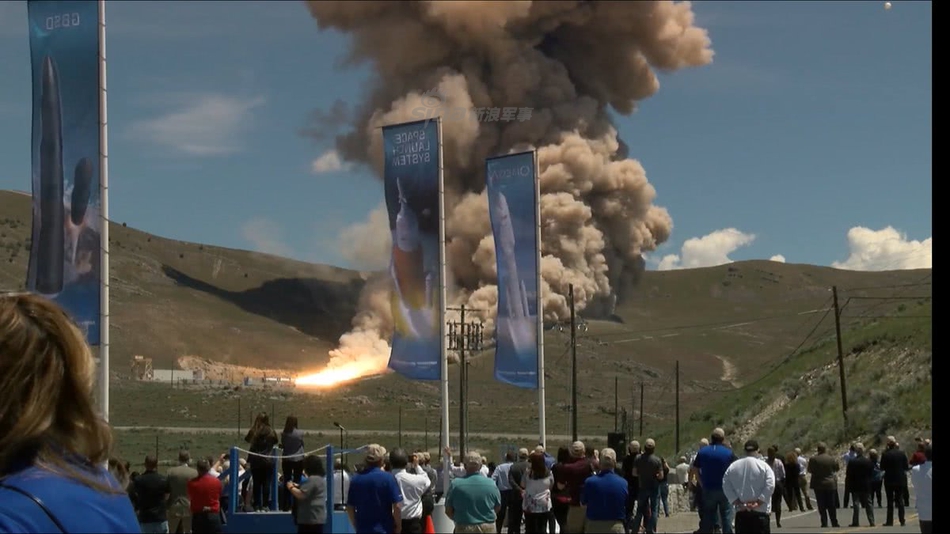
- 当被问及如果在飞行期间发生同样的故障会发生什么情况时,罗明杰表示他们需要更多地查看数据。罗明格说:“我们看到的(爆炸)是在收尾的最后(发生的),意味着你可能(已经)获得了一个非常正常的标称推力曲线,但事实上我们需要通过数据来分析它。”
美测试新型火箭 接近尾声时发动机喷管突然爆裂!
支持 键翻阅图片 列表查看
全屏观看
2019.06.01 15:08:41
-
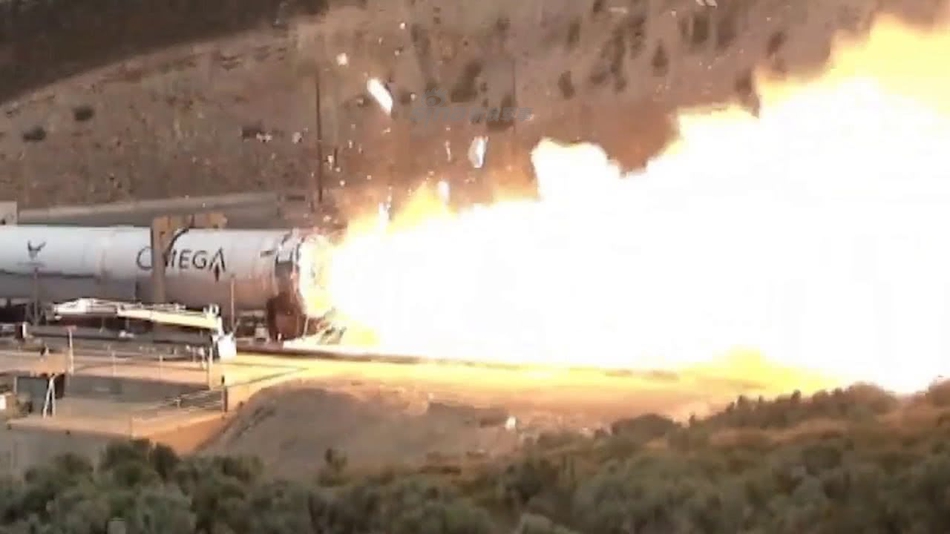
- 罗明格还指出,像这样的异常现象(的出现)正是公司在火箭飞行前对其进行测试的原因。他说,“我们将深入研究和分析这些数据,看看它能告诉我们什么。”
支持 键翻阅图片 列表查看
全屏观看
2019.06.01 15:08:41
-
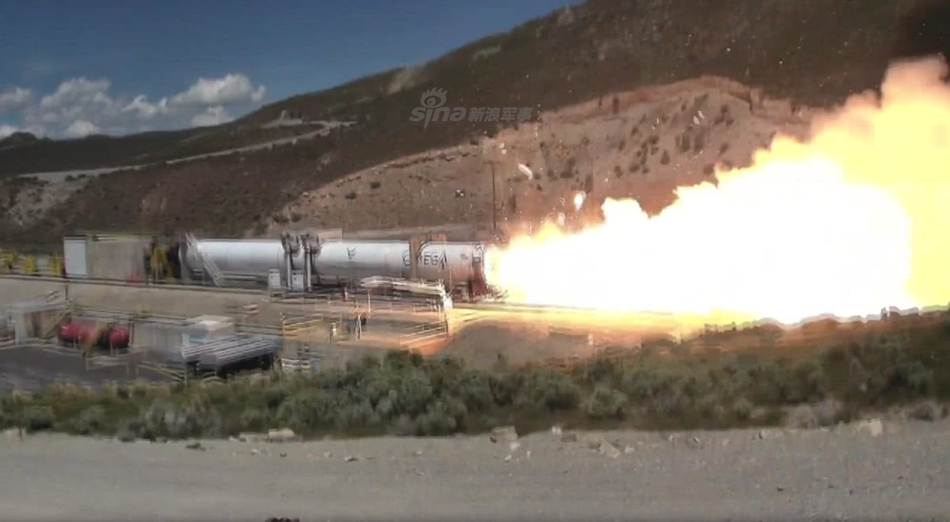
- 据悉,“欧米茄”是诺格公司研制的下一代运载火箭,从用于帮助发射航天飞机的固体火箭助推器中衍生而来。美国军工企业诺格公司一直在开发火箭为美国政府发射有效载荷。
美测试新型火箭 接近尾声时发动机喷管突然爆裂!
支持 键翻阅图片 列表查看
全屏观看
2019.06.01 15:08:41
-
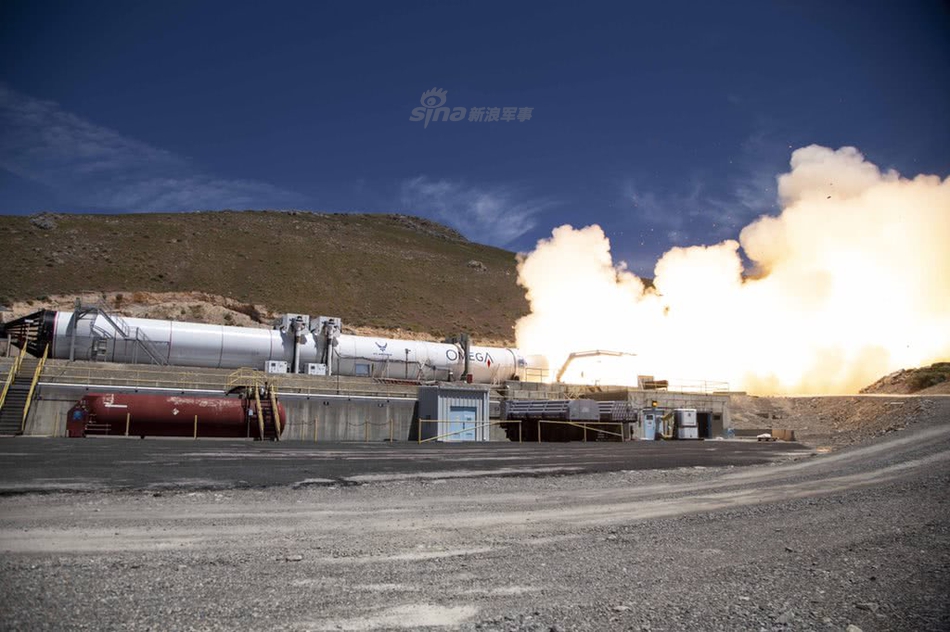
- 去年11月,诺格公司从美国空军那里获得了7.916亿美元用于“欧米茄”火箭的进一步开发,因此该火箭很可能在未来发射国家安全有效载荷。
支持 键翻阅图片 列表查看
全屏观看
2019.06.01 15:08:41
-
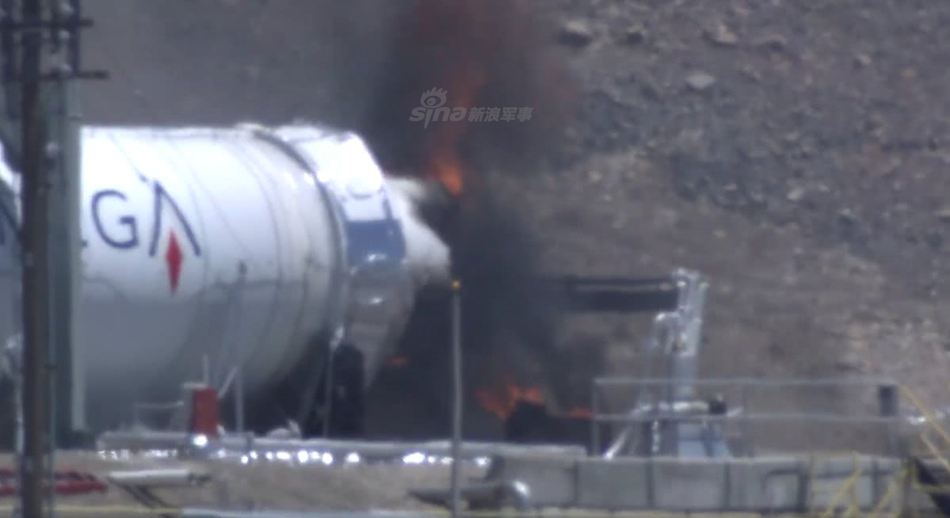
- 很快,美国空军将选择两家公司在2022年至2026年之间发射所有军用卫星,而诺格公司将是竞标这些合同的四家公司之一。(环球时报)(责任编辑:王朋飞 SN195)
Http://slide.mil.news.sina.com.cn/k/slide_8_197_72192.html#p=1
US test new rocket The engine nozzle suddenly bursts near the end!
Support button flip through pictures list view
Full screen view
2019.06.01 15:08:41
1 / 8
According to the US science and technology news website The Verge, on May 30th, local time, Northrop Grumman developed the "OmegA" carrier rocket-class solid rocket engine, a test site in Promonte, Utah. The first full static ignition test was conducted.
US test new rocket The engine nozzle suddenly bursts near the end!
Support button flip through pictures list view
Full screen view
2019.06.01 15:08:41
2 / 8
The test run lasted for a full 122 seconds, but at the end of the test, the nozzle portion of the engine suddenly exploded, and the debris of the parts scattered around. This seems to indicate that Nog’s first large-scale test of the “Omega” launch vehicle ended in failure, but Nogg still claims that the test drive was successful.
US test new rocket The engine nozzle suddenly bursts near the end!
Support button flip through pictures list view
Full screen view
2019.06.01 15:08:41
3 / 8
At the press conference after the ignition test, the former vice president of Nogruman and the head of the Omega transport system business opportunity acquisition, former US astronaut Kent Rominger said: "At the end of the engine, we observed the exit. There are some strange phenomena in the cone or part of it, and we need to investigate further."
US test new rocket The engine nozzle suddenly bursts near the end!
Support button flip through pictures list view
Full screen view
2019.06.01 15:08:41
When asked what would happen if the same failure occurred during the flight, Luo Mingjie said they needed to see more data. Luo Mingge said: "What we see (explosion) is at the end of the closing (occurring), meaning that you may (already) get a very normal nominal thrust curve, but in fact we need to analyze through the data it."
US test new rocket The engine nozzle suddenly bursts near the end!
Support button flip through pictures list view
Full screen view
2019.06.01 15:08:41
Luo Mingge also pointed out that anomalies like this are the reason why the company tested the rocket before it flew. He said, "We will delve into and analyze these data to see what it can tell us."
US test new rocket The engine nozzle suddenly bursts near the end!
Support button flip through pictures list view
Full screen view
2019.06.01 15:08:41
It is reported that "Omega" is a next-generation launch vehicle developed by Nogg, which is derived from the solid rocket booster used to help launch the space shuttle. The US military company Nog has been developing rockets to launch payloads for the US government.
US test new rocket The engine nozzle suddenly bursts near the end!
Support button flip through pictures list view
Full screen view
2019.06.01 15:08:41
In November last year, Nogg obtained $791.6 million from the US Air Force for further development of the "Omega" rocket, so the rocket is likely to launch a national security payload in the future.
US test new rocket The engine nozzle suddenly bursts near the end!
Support button flip through pictures list view
Full screen view
2019.06.01 15:08:41
Soon, the US Air Force will choose two companies to launch all military satellites between 2022 and 2026, and Nogg will be one of the four companies bidding for these contracts. (Global Times) (Editor: Wang Pengfei SN195)
http://slide.mil.news.sina.com.cn/k/slide_8_197_72192.html#p=1
美测试新型火箭 接近尾声时发动机喷管突然爆裂!
支持 键翻阅图片 列表查看
全屏观看
2019.06.01 15:08:41
1 / 8
据美国科技新闻网站The Verge报道,当地时间5月30日,诺斯罗普·格鲁曼公司研发的“欧米茄”(OmegA)运载火箭一级固体火箭发动机,在犹他州普罗蒙特里的试验场进行了第一次全面静态点火测试。
美测试新型火箭 接近尾声时发动机喷管突然爆裂!
支持 键翻阅图片 列表查看
全屏观看
2019.06.01 15:08:41
试车持续了整整122秒,但在接近尾声时,发动机的喷管部位疑似突然爆裂,零部件碎片四处飞散。这似乎表明诺格公司对“欧米茄”运载火箭的首次大型测试以失败而告终,但诺格公司仍声称称试车是成功的
美测试新型火箭 接近尾声时发动机喷管突然爆裂!
支持 键翻阅图片 列表查看
全屏观看
2019.06.01 15:08:41
3 / 8
在点火试车结束后举行的新闻发布会上,诺格鲁曼公司副总总裁兼“欧米茄”运载系统商机捕获主管、前美国宇航员肯特·罗明杰说:“在发动机收尾的最后,我们观察到出口锥或者可能其一部分发生了一些奇怪的现象,(对此)我们需要进一步调查。”
美测试新型火箭 接近尾声时发动机喷管突然爆裂!
支持 键翻阅图片 列表查看
全屏观看
2019.06.01 15:08:41
-

- 当被问及如果在飞行期间发生同样的故障会发生什么情况时,罗明杰表示他们需要更多地查看数据。罗明格说:“我们看到的(爆炸)是在收尾的最后(发生的),意味着你可能(已经)获得了一个非常正常的标称推力曲线,但事实上我们需要通过数据来分析它。”
美测试新型火箭 接近尾声时发动机喷管突然爆裂!
支持 键翻阅图片 列表查看
全屏观看
2019.06.01 15:08:41
-

- 罗明格还指出,像这样的异常现象(的出现)正是公司在火箭飞行前对其进行测试的原因。他说,“我们将深入研究和分析这些数据,看看它能告诉我们什么。”
支持 键翻阅图片 列表查看
全屏观看
2019.06.01 15:08:41
-

- 据悉,“欧米茄”是诺格公司研制的下一代运载火箭,从用于帮助发射航天飞机的固体火箭助推器中衍生而来。美国军工企业诺格公司一直在开发火箭为美国政府发射有效载荷。
美测试新型火箭 接近尾声时发动机喷管突然爆裂!
支持 键翻阅图片 列表查看
全屏观看
2019.06.01 15:08:41
-

- 去年11月,诺格公司从美国空军那里获得了7.916亿美元用于“欧米茄”火箭的进一步开发,因此该火箭很可能在未来发射国家安全有效载荷。
支持 键翻阅图片 列表查看
全屏观看
2019.06.01 15:08:41
-

- 很快,美国空军将选择两家公司在2022年至2026年之间发射所有军用卫星,而诺格公司将是竞标这些合同的四家公司之一。(环球时报)(责任编辑:王朋飞 SN195)
US test new rocket The engine nozzle suddenly bursts near the end!
Support button flip through pictures list view
Full screen view
2019.06.01 15:08:41
1 / 8
According to the US science and technology news website The Verge, on May 30th, local time, Northrop Grumman developed the "OmegA" carrier rocket-class solid rocket engine, a test site in Promonte, Utah. The first full static ignition test was conducted.
US test new rocket The engine nozzle suddenly bursts near the end!
Support button flip through pictures list view
Full screen view
2019.06.01 15:08:41
2 / 8
The test run lasted for a full 122 seconds, but at the end of the test, the nozzle portion of the engine suddenly exploded, and the debris of the parts scattered around. This seems to indicate that Nog’s first large-scale test of the “Omega” launch vehicle ended in failure, but Nogg still claims that the test drive was successful.
US test new rocket The engine nozzle suddenly bursts near the end!
Support button flip through pictures list view
Full screen view
2019.06.01 15:08:41
3 / 8
At the press conference after the ignition test, the former vice president of Nogruman and the head of the Omega transport system business opportunity acquisition, former US astronaut Kent Rominger said: "At the end of the engine, we observed the exit. There are some strange phenomena in the cone or part of it, and we need to investigate further."
US test new rocket The engine nozzle suddenly bursts near the end!
Support button flip through pictures list view
Full screen view
2019.06.01 15:08:41
When asked what would happen if the same failure occurred during the flight, Luo Mingjie said they needed to see more data. Luo Mingge said: "What we see (explosion) is at the end of the closing (occurring), meaning that you may (already) get a very normal nominal thrust curve, but in fact we need to analyze through the data it."
US test new rocket The engine nozzle suddenly bursts near the end!
Support button flip through pictures list view
Full screen view
2019.06.01 15:08:41
Luo Mingge also pointed out that anomalies like this are the reason why the company tested the rocket before it flew. He said, "We will delve into and analyze these data to see what it can tell us."
US test new rocket The engine nozzle suddenly bursts near the end!
Support button flip through pictures list view
Full screen view
2019.06.01 15:08:41
It is reported that "Omega" is a next-generation launch vehicle developed by Nogg, which is derived from the solid rocket booster used to help launch the space shuttle. The US military company Nog has been developing rockets to launch payloads for the US government.
US test new rocket The engine nozzle suddenly bursts near the end!
Support button flip through pictures list view
Full screen view
2019.06.01 15:08:41
In November last year, Nogg obtained $791.6 million from the US Air Force for further development of the "Omega" rocket, so the rocket is likely to launch a national security payload in the future.
US test new rocket The engine nozzle suddenly bursts near the end!
Support button flip through pictures list view
Full screen view
2019.06.01 15:08:41
Soon, the US Air Force will choose two companies to launch all military satellites between 2022 and 2026, and Nogg will be one of the four companies bidding for these contracts. (Global Times) (Editor: Wang Pengfei SN195)
https://www.theverge.com/2019/5/30/...mmans-omega-rocket-static-fire-test-explosion
Northrop Grumman’s new rocket suffers small explosion during first big ignition test
10 comments
The company says the test was still a success
By Loren Grush@lorengrush May 30, 2019, 5:02pm EDT
Share
Image: YouTube/Northrop Grumman
Northrop Grumman’s first big test of its future OmegA rocket seems to have ended in a small explosion. Today, the company fired up the main engine on the rocket during a ground test in Utah. Toward the end of the test, part of the vehicle’s engine burst apart, sending pieces of hardware flying.
Today’s test is what is known as a static fire, when the engine of a rocket is ignited while the vehicle is held firmly to the ground. Northrop Grumman was conducting the very first static fire test of the OmegA’s first stage — the main body of the rocket with the primary engine attached to the end. The first stage was ignited horizontally at Northrop Grumman’s test facility in Promontory, Utah, with the goal of testing out all of the rocket’s systems as one functioning unit.
“we observed the exit cone and maybe a portion of it doing something a little strange.”
The ignition lasted for a full 122 seconds, sending flames and plumes of gas out into the Utah desert. But just before the firing shut off, the nozzle of the OmegA engine — the large cylindrical cone that the gas and fire flow through — seemingly exploded. Northrop Grumman claims that the test was still successful, despite “an observation noted at the very end of test,” involving the nozzle.
:no_upscale()/cdn.vox-cdn.com/uploads/chorus_asset/file/16309785/OmegA_MaxQ_high.jpg)
“At the very end when the engine was tailing off, we observed the exit cone and maybe a portion of it doing something a little strange that we need to go further look into,” Kent Rominger, a former astronaut and Northrop Grumman’s vice president and capture lead for OmegA launch system, said during a press conference after the firing. When asked what would happen if this same failure occurred during a flight, Rominger said they’d need to look at the data some more. “What we saw was at the very end of the tail off — means you could have had a very normal, nominal thrust profile,” Rominger said. “But the truth is we need to go pull the data to analyze that.”
“the truth is we need to go pull the data to analyze that.”
The OmegA is Northrop Grumman’s next-generation rocket, derived from the solid rocket boosters that were used to help launch the Space Shuttle. The company has been developing the rocket to launch payloads for the US government. In November, Northrop Grumman received $791.6 million from the US Air Force for further development of the OmegA, so that the rocket could potentially launch national security payloads in the future. Soon, the Air Force will select two companies to launch all of the military’s satellites between 2022 and 2026 — and Northrop Grumman is one of four companies that will be bidding for those contracts.
Rominger noted that anomalies like this one are the reason that companies test their rockets before they fly them. “We will go dig into this data and see what it tells us,” he said.
https://www.space.com/northrop-grumman-test-fires-omega-rocket.html
Northrop Grumman Investigates Anomaly from 1st OmegA Rocket Motor Test
By Mike Wall 2 days ago Spaceflight
The full-scale test didn't go off without a hitch.
CLOSE
A powerful new rocket showed its stuff today (May 30) during a dramatic ground test that didn't go exactly as planned.
Aerospace company Northrop Grumman fired the first stage of its OmegA launcher this afternoon for the first time, at the company's facility in Promontory, Utah. Near the end of the 122-second burn, part of the booster's nozzle appeared to explode, sending pieces flying far and wide.
Despite this unintended "observation," today's trial went well, Northrop Grumman representatives said. The rocket motor performed normally and generated the prescribed 2 million lbs. of maximum thrust, they stressed.
Related: 3 Huge New Rockets Are on Track for 1st Test Flights in 2021
Image 1 of 3

The first stage of Northrop Grumman's OmegA rocket fires for the first time during a full-scale ground test in Utah on May 30, 2019.
(Image: © Northrop Grumman)

Pieces of the nozzle on Northrop Grumman's OmegA rocket first stage fly during a full-scale ground test in Utah on May 30, 2019.
(Image: © Northrop Grumman)
OmegA Rocket Nozzle Apparently Damaged During Test

The nozzle on the first stage of Northop Grumman's OmegA rocket just after the full-scale firing on May 30, 2019.
(Image: © Northrop Grumman)
OmegA Rocket Nozzle Apparently Damaged During Test
"What we observed today was a successful test," Kent Rominger, OmegA vice president at Northrop Grumman, said during a telecon with reporters after today's test. "It appears everything worked very, very well."
Everything, that is, except the nozzle's aft exit cone, a portion of which did "something a little strange that we need to go further look into," Rominger said.
It's too soon to speculate about what exactly caused the issue with the exit cone, he added.
"This is why you test," Rominger said. "We'll go dig into this data."
Northrop Grumman plans to conduct a similar test of the OmegA second stage this fall.
The Virginia-based company is developing OmegA to fly national-security and commercial missions. If all goes according to plan, the rocket will perform its first test flight in 2021 and begin operational launches the next year.
The three-stage OmegA will come in both an intermediate and a heavy-lift version. The heavy variant will be capable of lofting 17,200 lbs. (7,800 kilograms) to geostationary equatorial orbit, according to the OmegA fact sheet.
OmegA began as a project of aerospace company Orbital ATK, which was acquired by Northrop Grumman in 2018.
- The World's Tallest Rockets: How They Stack Up
- Orbital ATK Developing New Rocket Family to Compete with SpaceX, ULA
- Acquisition of Orbital ATK Approved, Company Renamed Northrop Grumman Innovation Systems
Mike Wall's book about the search for alien life, "Out There" (Grand Central Publishing, 2018; illustrated by Karl Tate), is out now. Follow him on Twitter @michaeldwall. Follow us on Twitter @Spacedotcom or Facebook.
Have a news tip, correction or comment? Let us know at [email protected].
https://www.nasaspaceflight.com/2019/05/ngis-omega-fires-first-test-nozzle-incident-review/
NGIS OmegA fires for two minutes in first static test – nozzle incident under review
written by Justin Davenport May 30, 2019

The Northrop Grumman Innovation Systems (formerly Orbital ATK) OmegA rocket conducted a key test today when its Castor 600 first stage fired for two minutes today at the NGIS test facility in Promontory, Utah, at the same test stand used by numerous Space Shuttle and SLS solid rocket motors during their test firings, although there was a situation with the nozzle that NGIS is looking at more closely.
After the end of the Ares 1 and Liberty launch vehicle projects, Orbital ATK developed a next generation launch vehicle concept to compete for future US Air Force and NASA launches, and won a rocket propulsion system (RPS) contract in January 2016 as part of the Air Force’s effort to end its dependence on Russian RD-180 engine imports, due to increased geopolitical tensions between the West and Russia.
The contract enabled Orbital ATK to keep working on the next generation launch system, which was later named OmegA, with the first and last letters capitalized to incorporate the company’s initials.
OmegA's promo video. First launch in 2021. pic.twitter.com/WQwB7Ts1Rp
— Chris B – NSF (@NASASpaceflight) May 30, 2019
— Chris B – NSF (@NASASpaceflight) May 30, 2019
In June 2018 Orbital ATK was acquired by Northrop Grumman to become Northrop Grumman Innovation Systems (NGIS), and in October of that year the US Air Force awarded NGIS a launch service agreement (LSA) contract initially worth $181 million for the first 18 months, and ultimately worth $792 million, to develop, build, and test the OmegA rocket, culminating in four test flights of two configurations starting in 2021.
See Also
NGIS, United Launch Alliance, and Blue Origin were the three companies that won money for Phase 1 of the Air Force contract, with two contractors to be selected later for a five year block of operational missions for Phase 2.
The OmegA, in its intermediate configuration, consists of a two segment Space Shuttle SRB-derived CBS (Common Booster System) Castor 600 first stage and a single segment Castor 300 second stage, as well as a liquid fueled (hydrogen and oxygen) third stage powered by Aerojet Rocketdyne RL-10C engines, which have extensive flight heritage.
In addition, the OmegA can have 1 to 6 smaller GEM-63XLT strap-on boosters mounted on the Castor 600 first stage and jettisoned in flight, to allow for heavier payloads to meet the full spectrum of national security launch needs. Finally, the OmegA features a 5 meter composite payload fairing with ESPA capable rings.
The OmegA intermediate configuration noted above (without GEM-63XLT) is scheduled to fly the first contracted test launch of the OmegA in 2021, while the second OmegA is set to fly the same intermediate configuration later that year but with two GEM-63XLT strap-on boosters added.

The OmegA first stage during the test – via Justin Davenport for NSF
The intermediate configuration is expected to fly the lion’s share of OmegA missions. An OmegA heavy configuration is also being developed, with a 4 segment Castor 1200 first stage and a single segment Castor 300 second stage, along with the RL-10C powered third stage and optional GEM-63XLT strap-on boosters.
The OmegA intermediate configuration will be capable of launching from 10,800 to 22,300 pounds (4900 to 10100 kilograms) to geostationary transfer orbit (GTO), while the heavy configuration can launch 11,570 to 17,200 pounds (5250 to 7800 kilograms) directly to geostationary equatorial orbit (GEO).
Launches will initially take place from the Kennedy Space Center Pad 39B, and High Bay 2 in the Vehicle Assembly Building (VAB) will be used to stack the OmegA for launch, on Mobile Launch Platform-3 (MLP-3) which was used for Space Shuttle flights and will be suitably modified for OmegA operations.

OmegA on 39B at KSC – via NGIS
NGIS hopes to have Vandenberg Air Force Base SLC-6 available for OmegA polar orbit flights after 2023 when the Delta 4 Heavy is set to make its final flight.
A single OmegA CBS consists of a 12.2 foot diameter composite filament-wound casing and propellant, and is 12 feet longer than a Space Shuttle or SLS segment. The Castor 600 aft segment is the heaviest segment NGIS has ever developed in all its incarnations, with 33,000 gallons of propellant (the previous record was 27,000 gallons for an SLS segment), totaling 650,000 pounds of propellant. In addition NGIS made its largest ever single propellant casting during the assembly process.
Also though NGIS frequently discusses the proven flight heritage of the vehicle, the Omega nozzle, skirt, and segment are different from the Shuttle and SLS and the vehicle was developed from scratch in 4 years, with the first test being predicted for May 2019 when development started in earnest in 2015. The CBS segments, like the SLS and Space Shuttle segments, are all built at the ATK/NGIS facilities in Utah, using similar processes and equipment.

OmegA first stage at the test site – via Justin Davenport for NSF
Prior to the test, the critical hardware was progressing to plan, and the project was meeting its schedules, which the NGIS management was very happy about. The OmegA CBS had passed its key tests during assembly and development, which included hydro burst testing using water to fill the composite case until it burst. The maximum expected pressure during flight was 1200 pounds and the casing burst well above that figure, which gave NGIS confidence about the OmegA segment integrity.
The part of the OmegA CBS tested today was the Castor 600 2 segment first stage, measuring 80 feet long, with mockup second and third stages attached, to make the assembly the same length as the actual vehicle. The Castor 600 tested today was heated to 90 degrees Fahrenheit and as a result the thrust was a little greater than the value expected at more normal temperatures.
The test countdown went smoothly, and the Castor 600 segment ignited on time at 1:05 pm Mountain with 2.2 million pounds of thrust. The ignition was very similar to previous shuttle/SLS SRB tests and the test burn looked very smooth and typical until two seconds before the Castor 600 finished burning, when nozzle pieces were seen flying away from the booster.
The burn quenching otherwise looked normal although there were reports of an issue on the test radio net and replays of the test clearly showed something happening in the area of the nozzle before booster shutdown.
The press conference held an hour after the test did not go into detail about what might have happened with the nozzle, and NGIS Vice President of Strategic Programs (and former Shuttle astronaut) Kent Rominger, although saying “generally very pleased” with the test advised that the quick look still had several hours to go and NGIS would look at the data extensively before any impact to the program going forward would be determined.
Successful test statement and what they saw with the nozzle. pic.twitter.com/jPaLloArUm
— Chris B – NSF (@NASASpaceflight) May 30, 2019
— Chris B – NSF (@NASASpaceflight) May 30, 2019
There were over 700 channels of data monitoring the test, which will no doubt be helpful to NGIS during the post-test data look, and the full look at the data would take 2 days, while disassembly of the test motor would take 2 months. As for whether the nozzle “observation” would have caused an issue during flight, it was pointed out that the thrust level could remain normal, but there was no detail given about what else could have happened in flight during that situation.
Future tests will be conducted on the Castor 300 (currently in the August-September timeframe) and GEM-63XLT (derived from the GEM-63 rocket tested earlier this year and last) before the OmegA’s 2021 first flight, with the OmegA being declared operational in 2022 and the heavy configuration following with two test flights starting in 2024.
Future flights of OmegA beyond the four test flights will depend on whether the rocket is selected for the USAF Phase 2 operational missions.

